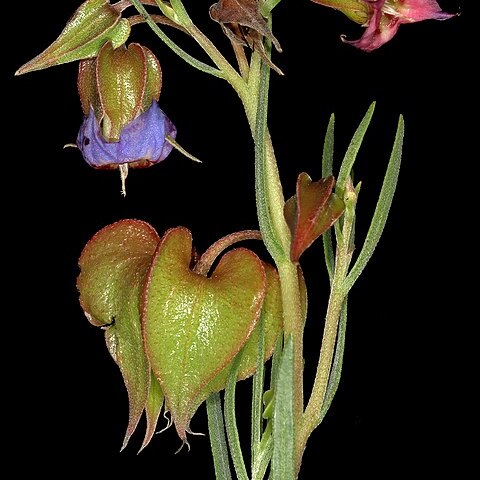Fruit comprising four nutlets, falling separately to leave a pyramidal gynobase, with four strongly concave sides and a persistent terminal style; nutlets 7–8 x 5–6 x c. 1 mm., compressed-ovoid, the outer surface covered with conical projections c. 1.5 mm. long, each with a minute apical barb and sometimes additional reflexed barbs below the apex, the marginal projections usually coalescing at their bases to form a distinct rim.
Perennial herb or subshrub, 500(-600) mm tall. Pedicels and inflorescence axes with appressed setae. Sepals 2.5-4.0 mm broad. Corolla 12-18(-22) mm long. Nutlets 4, glochidiate. Leaves linear to linear-elliptic; 1-6(-9) mm broad. Flowers blue or sometimes pinkish blue.
Sepals 9–12 x 2.5–4 mm. at flowering, lanceolate, cordate at the base, long-acute at the apex, enlarging to up to 25 x 20 mm. in fruit and then ovate, strongly cordate and becoming papery, rather regularly covered by short appressed setae at all times.
Inflorescences 1–5 cm. long, with 2–8 flowers, terminal and ebracteate or the lowermost flowers sometimes solitary in leaf axils; pedicels 1–2 cm., or up to 3 cm. in fruit, clothed with appressed setae.
Perennial herb to bushy subshrub with erect or decumbent-ascending stems up to 50(60) cm.; stems with short appressed or ascending tuberculate setae, the epidermis often flaking off in older plants.
Corolla 12–18(22) mm. long, the tube about equalling the sepals, the ovate-acuminate lobes reflexed over the sepals, with markedly elongate apices, blue or sometimes pinkish-blue.
Leaves 2–7 x 0.1–0.6(0.9) cm., linear to linear-elliptic, narrowly cuneate at base, acute at apex, with tuberculate short appressed setae on both surfaces.

